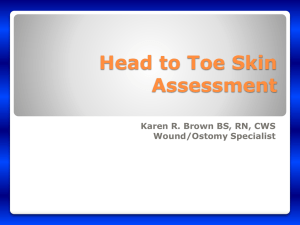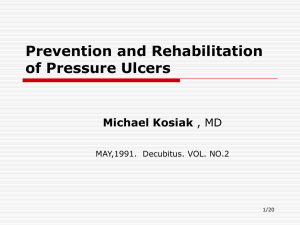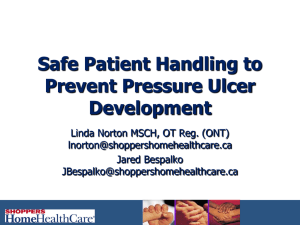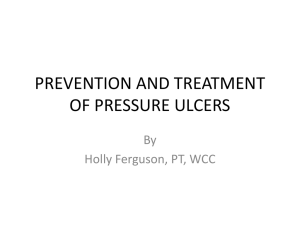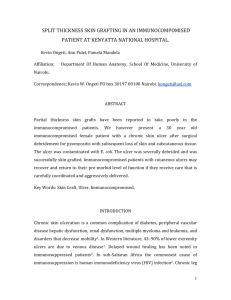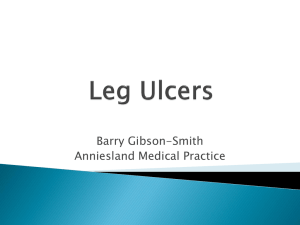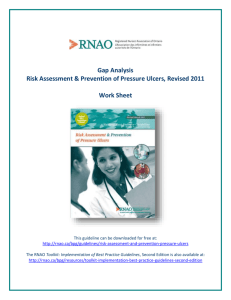07PT_Wounds_What_can_we_do
advertisement
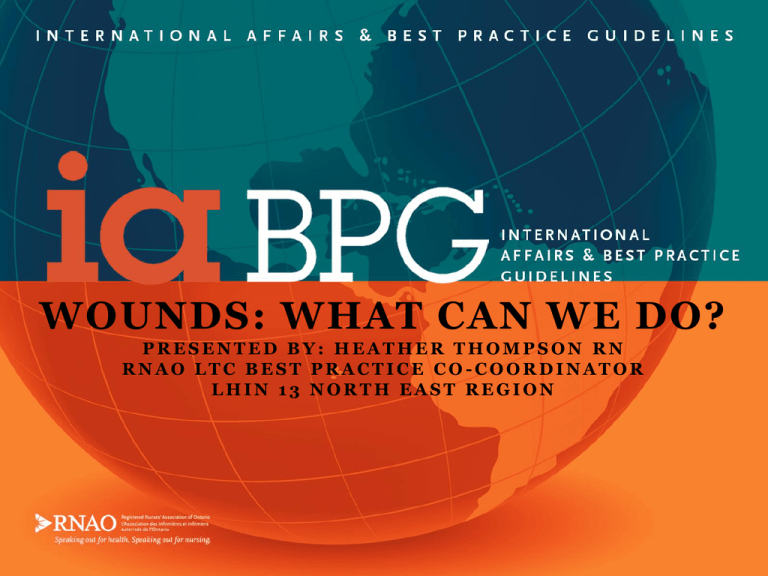
WOUNDS: WHAT CAN WE DO? PRESENTED BY: HEATHER THOMPSON RN RNAO LTC BEST PRACTICE CO-COORDINATOR LHIN 13 NORTH EAST REGION Objectives Define a pressure ulcer Identify risk factors or warning signs Discuss Best Practices related to wound prevention and treatment plans Discuss the “Team” and your role in wound care Hand on exercise: “Tender touch” “Your are tearing me apart” “ Orange you glad we did this” Key Terms Friction- mechanical force exerted on the skin Shearing- skin remains stationary and underlying tissue moves, tears and stretches BPG- (Best Practice Guideline) Team- client, family, care giver, nurse, Doctor, Occupational and Physical therapist, Dietician and more Braden Scale - useful assessment tool to determine risk of skin breakdown Moisture- due to incontinence or perspiration Sensory – ability to feel and understand Nutrition – protein to assist in healing Wound Definition “an area of localized damage to the skin and underlying tissue caused by pressure, shear, friction and/or a combination of these” European Pressure Ulcer Advisory Panel EPUAP (2003) Typically found over bony areas and can occur anywhere The tissue does not receive adequate nutrition and becomes necrotic and dies Wounds are staged based on degree of tissue damage. What do we know? Preventing the development of pressure ulcers is a huge challenge Data (1990-2003) shows 29% incidence in Canada Further challenged by limited resources Costs, knowledge and time to name a few Myths and Truth Myth Pressure Ulcers are prevented by nurses Sheepskin prevent Pressure Ulcers Pressure redistribution surface prevents Pressure Ulcer alone Truth It takes team work: Client, Family, Care giver, Nurse, Doctor, Physical and Occupational therapist, Dietitian Made of wool and polyester, reduce friction at start but material deteriorates quickly They help but client still needs repositioning What can we do? Knowledge Prevention Protection Assessment Communication Teamwork Best Practice Guideline Assessment & Management of Stage I – IV Pressure Ulcers And Risk Assessment & Prevention of Pressure Ulcers Free download at http://ltctoolkit.rnao.ca Evidence-Based Practice Evidence-based practice is the integration of best research evidence with clinical expertise and patient values to facilitate clinical decision making. DiCenso et al., 2005 What the Wound BPG can do? To demonstrate that the implementation of a standardized skin and wound care program, partnered with an ongoing educational program has a result in the reduction of internally acquired pressure ulcers. Function of the skin Protects to keeps harmful substances out; keeps water and electrolytes in Supports internal structures and organs Assists in production of vitamin D Performs excretory function Performs sensory role Assists in regulating body temperature Skin Largest organ Two layers: Epidermis Dermis Subcutaneous tissue So how do pressure ulcers form Greatest damage over bony prominence Ulcer already started by the time you see the redness Can increase in severity in just one day if not addressed Pressure over area will significantly decrease the blood flow and delivery of nutrients to an area, causing eventual death of cells Staging of Wounds Stage 1 − discolouration of the skin, warmth, swelling or hardness Stage 2− partial thickness skin loss involving epidermis or dermis, or both. May look like an abrasion or blister Staging of Wounds Stage 3– full thickness skin loss involving damage to or cell death of underlying tissue, may extend down to, but not through, fibrous tissue beneath the skin Stage 4 – extensive tissue cell death, or damage to muscle, bone or supporting structures with or without full thickness skin loss Risk Factors Uncontrolled Controlled Age and gender Positioning Body size Shearing and Friction Medication Medical condition Nutritional and hydration status Mobility Environment moisture Surface areas Mobility Environment Nutritional and hydration status moisture Watch for Warning Signs Incontinent Excessive perspiration Cannot change position on own, limited mobility Weight loss, dehydration Discoloured, swollen skin over bony areas or skin tear areas Poor circulation, history of pressure ulcers Decrease in senses Pain Action to Protection Assessment of risks weekly performed by client, caregiver, nurse. Use of effective tool (Braden Scale) Communicate results Improved nutrition: Dietician assessment ongoing, act on dietician suggestions Communicate results Physical Therapist assessment to maintain or improve mobility, Occupational Therapist assessment Communicate results Action to Protection Manage Moisture: Moisture increases the risk for pressure ulcers. Two sources of moisture are urine and sweat. Manage Nutrition & Hydration: Nutrition and Hydration are important in keeping skin healthy Manage Friction, Sheer and Pressure: Reducing friction, sheer and pressure helps to prevent pressure ulcers. Manage Repositioning: Repositioning helps prevent pressure ulcers. Manage Sensory/Perception: If a patient is unable to feel pain or pressure normally, they can be injured without knowing it. Pain Management http://ltctoolkit.rnao.ca/sites/ltc/files/resources/pressure_ulcer/AssessmentTools/Painmangementflowre cord.pdf Severity of pain pre-treated Location of pain Quality of pain Regular pain medication time Non-pharmacological treatment Severity of pain post treatment What to Report Pressure, shearing, friction level of mobility sensory impairment continence level of consciousness Exacerbation of acute, chronic and terminal illness What to Report Posture Cognition, psychological status Previous pressure damage Nutrition and hydration status Moisture to the skin Pressure Relief Devices Heel and elbow protectors Bed cradle and foot board Air flow mattress Alternating pressure bed Special cushions for chair Other Actions Nutritional support Skin barriers Positioning techniques Incontinence management program (Best Practice Guidelines: Promoting Continence using Prompted Voiding and Prevention of Constipation in the older Adult Population) Education Communication Summary of Wound management History, physical assessment, motivation for treatment Involve the client, family, dietary, OT, PT, nurses, dietician and care giver Ongoing assessment or at least every 3 months and when there is a change in condition Contributing factors: mattress, surface supports, transfer type, mobility, nutrition and knowledge Look at the whole person Team Roles Resident – prevention, treatment plan, communication PSW and Care Giver – prevention, skin screening, treatment evaluation, communication Nurse –prevention, pain control, assessment, treatment, evaluation, communication OT and PT –prevention, physical assessments, treatment, evaluation, communication Family – prevention, care routines, communication Knowledge can be Fun Exercise “Tender Touch” Exercise “ You are tearing me apart” Exercise “Orange you glad we did this” Questions and Discussion References RNAO. (2007, March). Assessment & Management of Stage I-IV Pressure Ulcers. RNAO. (2005, March). Risk Assessment & Prevention of Pressure Ulcers. Potter & Perry. (2006). Canadian Fundamentals of Nursing 3rd ed. Chapt. 43 Potter & Perry. (2006). Clinical Nursing Skills & Techniques 6th ed. Chapt. 13 Website resource: http://ltctoolkit.rnao.ca Janet Evans BScN MN BPG Coordinator LHIN 11


